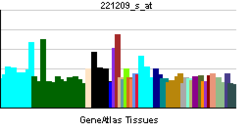- OTOR
-
Otoraplin Identifiers Symbols OTOR; FDP; MGC126737; MGC126739; MIAL; MIAL1 External IDs OMIM: 606067 MGI: 1888678 HomoloGene: 10600 GeneCards: OTOR Gene Gene Ontology Cellular component • extracellular region Biological process • cartilage condensation
• sensory perception of soundSources: Amigo / QuickGO RNA expression pattern 
More reference expression data Orthologs Species Human Mouse Entrez 56914 57329 Ensembl ENSG00000125879 ENSMUSG00000027416 UniProt Q9NRC9 Q548U4 RefSeq (mRNA) NM_020157 NM_020595.2 RefSeq (protein) NP_064542 NP_065620.1 Location (UCSC) Chr 20:
16.73 – 16.75 MbChr 2:
142.9 – 142.91 MbPubMed search [1] [2] Otoraplin is a protein that in humans is encoded by the OTOR gene.[1][2]
The protein encoded by this gene is secreted via the Golgi apparatus and may function in cartilage development and maintenance. A frequent polymorphism in the translation start codon of this gene can abolish translation and may be associated with forms of deafness. This gene is a member of the melanoma-inhibiting activity gene family. In addition, alternate polyA sites exist for this gene.[2]
References
- ^ Robertson NG, Heller S, Lin JS, Resendes BL, Weremowicz S, Denis CS, Bell AM, Hudspeth AJ, Morton CC (Sep 2000). "A novel conserved cochlear gene, OTOR: identification, expression analysis, and chromosomal mapping". Genomics 66 (3): 242–8. doi:10.1006/geno.2000.6224. PMID 10873378.
- ^ a b "Entrez Gene: OTOR otoraplin". http://www.ncbi.nlm.nih.gov/sites/entrez?Db=gene&Cmd=ShowDetailView&TermToSearch=56914.
Further reading
- Robertson NG, Khetarpal U, Gutiérrez-Espeleta GA, et al. (1995). "Isolation of novel and known genes from a human fetal cochlear cDNA library using subtractive hybridization and differential screening.". Genomics 23 (1): 42–50. doi:10.1006/geno.1994.1457. PMID 7829101.
- Cohen-Salmon M, Frenz D, Liu W, et al. (2001). "Fdp, a new fibrocyte-derived protein related to MIA/CD-RAP, has an in vitro effect on the early differentiation of the inner ear mesenchyme.". J. Biol. Chem. 275 (51): 40036–41. doi:10.1074/jbc.M002876200. PMID 10998416.
- Rendtorff ND, Frödin M, Attié-Bitach T, et al. (2001). "Identification and characterization of an inner ear-expressed human melanoma inhibitory activity (MIA)-like gene (MIAL) with a frequent polymorphism that abolishes translation.". Genomics 71 (1): 40–52. doi:10.1006/geno.2000.6409. PMID 11161796.
- Deloukas P, Matthews LH, Ashurst J, et al. (2002). "The DNA sequence and comparative analysis of human chromosome 20.". Nature 414 (6866): 865–71. doi:10.1038/414865a. PMID 11780052.
- Strausberg RL, Feingold EA, Grouse LH, et al. (2003). "Generation and initial analysis of more than 15,000 full-length human and mouse cDNA sequences.". Proc. Natl. Acad. Sci. U.S.A. 99 (26): 16899–903. doi:10.1073/pnas.242603899. PMC 139241. PMID 12477932. http://www.pubmedcentral.nih.gov/articlerender.fcgi?tool=pmcentrez&artid=139241.
- Clark HF, Gurney AL, Abaya E, et al. (2003). "The secreted protein discovery initiative (SPDI), a large-scale effort to identify novel human secreted and transmembrane proteins: a bioinformatics assessment.". Genome Res. 13 (10): 2265–70. doi:10.1101/gr.1293003. PMC 403697. PMID 12975309. http://www.pubmedcentral.nih.gov/articlerender.fcgi?tool=pmcentrez&artid=403697.
- Zhang Z, Henzel WJ (2005). "Signal peptide prediction based on analysis of experimentally verified cleavage sites.". Protein Sci. 13 (10): 2819–24. doi:10.1110/ps.04682504. PMC 2286551. PMID 15340161. http://www.pubmedcentral.nih.gov/articlerender.fcgi?tool=pmcentrez&artid=2286551.
- Gerhard DS, Wagner L, Feingold EA, et al. (2004). "The status, quality, and expansion of the NIH full-length cDNA project: the Mammalian Gene Collection (MGC).". Genome Res. 14 (10B): 2121–7. doi:10.1101/gr.2596504. PMC 528928. PMID 15489334. http://www.pubmedcentral.nih.gov/articlerender.fcgi?tool=pmcentrez&artid=528928.
Categories:- Human proteins
- Chromosome 20 gene stubs
Wikimedia Foundation. 2010.
